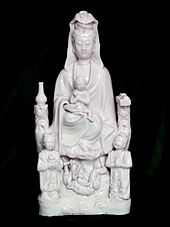Kakure Kirishitan

Kakure Kirishitan (Japanese: 隠れキリシタン, lit. 'hidden Christians') is a modern term for a member of the Catholic Church in Japan who went underground at the start of the Edo period in the early 17th century (lifted in 1873) due to Christianity's repression by the Tokugawa shogunate (April 1638).[1][2][3]
History
[edit]

Kakure Kirishitan are the Catholic communities in Japan which hid themselves during the ban and persecution of Christianity by Japan in the 1600s.[3][5]
Depictions of Mary modeled on the Buddhist deity Kannon (Avalokiteśvara), goddess of mercy, became common among Kakure Kirishitan, and were known as "Maria Kannon".[6] The prayers were adapted to sound like Buddhist chant, yet retained many untranslated words from Latin, Portuguese, and Spanish. The Bible and other parts of the liturgy were passed down orally, because printed works could be confiscated by authorities.[1]
Kakure Kirishitan were recognized by Bernard Petitjean, a Catholic priest, when Ōura Church was built in Nagasaki in 1865. Approximately 30,000 secret Christians, some of whom had adopted these new ways of practicing Christianity, came out of hiding when religious freedom was re-established in 1873 after the Meiji Restoration. The Kakure Kirishitan became known as Mukashi Kirishitan (昔キリシタン), or "ancient" Christians, and emerged not only from traditional Christian areas in Kyushu, but also from other rural areas of Japan.[1]
Some Kakure Kirishitan did not rejoin the Catholic Church, and became known as the Hanare kirishitan (離れキリシタン, separated Christians).[1][3] Hanare Kirishitan are now primarily found in Urakami and on the Gotō Islands.[2]
In the early 1990s, anthropologist Christal Whelan discovered some Hanare Kirishitans still living on the Gotō Islands where Kakure Kirishitans had once fled. There were only two surviving priests on the islands, both of whom were over 90, and they would not talk to each other. The few surviving laity had also reached old age, and some of them no longer had any priests from their lineage and prayed alone. Although these Hanare Kirishitans had a strong tradition of secrecy, they agreed to be filmed for Whelan's documentary Otaiya.[7]
The Kakure Kirishitan still exist today, forming "what is arguably a separate faith, barely recognizable as the creed imported in the mid-1500s by Catholic missionaries".[3]
See also
[edit]- Haibutsu kishaku
- Shinbutsu bunri
- Shinbutsu kakuri
- Shimabara Rebellion
- Crypto-Christianity
- Hidden Christian Sites in the Nagasaki Region
- Kakure nenbutsu, a form of Jōdo Shinshū Buddhism secretly practiced on the Japanese island of Kyushu, during a period of religious persecution from 1555 to the Meiji Restoration.
- Inquisition
- Laramans
- Mozarabs
- Marrano/Anusim/Converso – comparable group of hidden Jews in Spain and Portugal
- Nagasaki Prefecture
References
[edit]- ^ a b c d "S". Encyclopedia of Japan. Tokyo: Shogakukan. 2012. OCLC 56431036. Archived from the original on 25 August 2007.
- ^ a b "隠れキリシタン" [Kakure Kirishitan]. Dijitaru Daijisen (in Japanese). Tokyo: Shogakukan. 2012. OCLC 56431036. Archived from the original on 25 August 2007.
- ^ a b c d "Driven Underground Years Ago, Japan's 'Hidden Christians' Maintain Faith". NPR.org. October 11, 2015. Retrieved 2022-06-29.
- ^ Boxer, C.R. (1951). The Christian Century in Japan: 1549–1650. University of California Press. p. vi.
- ^ Morishita, Sylvie (2006-04-01). "Les « séparés » du Japon au XIXe siècle". Revue des sciences religieuses (in French) (80/2): 179–192. doi:10.4000/rsr.1874. ISSN 0035-2217.
- ^ Schumacher, Mark. "Virgin Mary & Kannon, Two Merciful Mothers". A to Z Photo Dictionary: Japanese Buddhist Statuary. Retrieved 11 May 2016.
- ^ "Kakure Kirishtan". 4 February 2000. Archived from the original on 14 April 2021. Retrieved 2 February 2022.
Further reading
[edit]- "Japan – Hidden Christians": Foreign Correspondent documentary
- "Ikitsuki Journal; Once Banned, Christianity Withers in an Old Stronghold", The New York Times, 25 December 2003.
- "Lack of Oppression Hurts Christianity in Japan", The New York Times, Sam Sloan, 3 April 1997, archived from the original on 27 September 2007.
- "Japan's Crypto-Christians", Time Magazine, archived from the original on July 21, 2008.
- Orasho, "Website of Churches and Christian Historical and Cultural Heritage of Nagasaki", operated for the Nagasaki Prefecture.
- Hidden Christian Sites in the Nagasaki Region, Nagasaki Prefectural World Heritage Division
- Hidden Christians: Part 1 (Television production). Japanology Plus. NHK. 2019-02-19. Includes a descendant of the Kakure Kirishitan reciting the Orasho.
